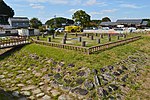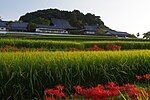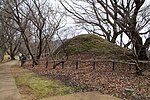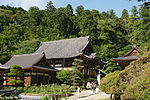Asuka-Fujiwara
Asuka-Fujiwara: Archaeological sites of Japan's Ancient Capitals and Related Properties is a cluster of archaeological sites from in and around the late sixth- to early eighth-century capitals of Asuka and Fujiwara-kyō, Nara Prefecture, Japan. In 2007, twenty-eight sites were submitted jointly for future inscription on the UNESCO World Heritage List under criteria ii, iii, iv, v, and vi.[1][2] As of 28 January 2025, the number of component sites in the nominated property has been reduced to nineteen.[3][4] Currently, the submission is included on the Tentative List.[1] The Japanese government is aiming for inscription in 2026.[5]
Since 2011, the Cultural Landscape of the Asuka Hinterland has been protected as one of the Cultural Landscapes of Japan.[6] An area of 60 ha is also protected within the Asuka Historical National Government Park.[7] Related artefacts are housed at the Asuka Historical Museum.[8]
Component sites
[edit]As of 28 January 2025, the nominated property comprises nineteen component sites:[3][4]
Previously-nominated component sites
[edit]The following sites formed part of the original submission:[2]
See also
[edit]- Asuka period
- List of National Treasures of Japan (archaeological materials)
- List of World Heritage Sites in Japan
References
[edit]- ^ a b "Asuka-Fujiwara: Archaeological sites of Japan's Ancient Capitals and Related Properties". UNESCO. Retrieved 11 February 2025.
- ^ a b "Monuments". Asuka Mura. Retrieved 2 Feb 2013.
- ^ a b c "About Asuka-Fujiwara". Asuka-Fujiwara World Heritage Inscription Promotion Council. Retrieved 11 February 2025.
- ^ a b 飛鳥・藤原の宮都(令和7年1月28日推薦) [Ancient Capitals of Asuka-Fujiwara (Recommended 28 January 2025)] (in Japanese). Agency for Cultural Affairs. Retrieved 11 February 2025.
- ^ "Japan recommends ancient capitals in Nara Pref. for UNESCO listing". The Mainichi. 28 January 2025. Retrieved 11 February 2025.
- ^ "奥飛鳥の文化的景観" [Cultural Landscape of the Asuka Hinterland]. Agency for Cultural Affairs. Retrieved 12 June 2012.
- ^ "Asuka Historical National Government Park". Asuka Historical National Government Park. Archived from the original on 6 November 2012. Retrieved 12 June 2012.
- ^ "Asuka Historical Museum". Nara National Research Institute for Cultural Properties. Archived from the original on 11 December 2012. Retrieved 12 June 2012.
- ^ "飛鳥京跡苑池" [Asuka Palace Ponds]. Agency for Cultural Affairs. Retrieved 12 June 2012.
- ^ 史跡 名勝 飛鳥京跡苑池 [Historic Site & Place of Scenic Beauty: Asuka Palace Pond] (in Japanese). Kashihara City. Retrieved 12 June 2012.
- ^ "飛鳥水落遺跡" [Asuka Mizuochi Site]. Agency for Cultural Affairs. Retrieved 12 June 2012.
- ^ 酒船石遺跡 [Sakafune Ishi Site] (in Japanese). Agency for Cultural Affairs. Retrieved 12 June 2012.
- ^ "飛鳥寺跡" [Asukadera Site]. Agency for Cultural Affairs. Retrieved 12 June 2012.
- ^ 橘寺境内 [Tachibanadera Precinct] (in Japanese). Agency for Cultural Affairs. Retrieved 12 June 2012.
- ^ 山田寺跡 [Yamadadera Site] (in Japanese). Agency for Cultural Affairs. Retrieved 12 June 2012.
- ^ 奈良県山田寺跡出土品 [Excavated Artefacts from Yamadadera] (in Japanese). Agency for Cultural Affairs. Retrieved 12 June 2012.
- ^ Parent, Mary Neighbour (1984). "Yamadadera: Tragedy and Triumph". Monumenta Nipponica. 39 (3). Sophia University: 307–331. doi:10.2307/2384596. JSTOR 2384596.
- ^ 川原寺跡 [Kawaradera Site] (in Japanese). Agency for Cultural Affairs. Retrieved 12 June 2012.
- ^ a b c McCallum, Donald F (2009). The Four Great Temples: Buddhist Archaeology, Architecture, and Icons of Seventh-Century Japan. University of Hawaii Press. ISBN 978-0-8248-3114-1.
- ^ 檜隈寺跡 [Hinokumadera Site] (in Japanese). Agency for Cultural Affairs. Retrieved 12 June 2012.
- ^ "Site of Hinokuma-dera". Kashihara City. Retrieved 14 May 2011.
- ^ Aston, W.G. (1972) [1896]. Nihongi: Chronicles of Japan from the Earliest Times to A.D. 697. Vol. 2. Tuttle. p. 379. ISBN 0-8048-0984-4.
- ^ 石舞台古墳 [Ishibutai Kofun] (in Japanese). Agency for Cultural Affairs. Retrieved 12 June 2012.
- ^ "Ishibutai Kofun". Asuka Historical Museum. Archived from the original on 24 April 2011. Retrieved 14 May 2011.
- ^ 菖蒲池古墳 [Shōbuike Kofun] (in Japanese). Agency for Cultural Affairs. Retrieved 12 June 2012.
- ^ "Shobu-ike Kofun". Asuka Historical Museum. Retrieved 14 May 2011.
- ^ 牽牛子塚古墳・越塚御門古墳 [Kengoshizuka Kofun・Koshitsukagomon Kofun] (in Japanese). Agency for Cultural Affairs. Retrieved 11 February 2025.
- ^ 大和国高市郡牽牛子塚古墳出土品 [Excavated Artefacts from Koshitsukagomon Kofun, Takaichi District, Yamato Province] (in Japanese). Agency for Cultural Affairs. Retrieved 11 February 2025.
- ^ 藤原宮跡 [Fujiwara Palace Site] (in Japanese). Agency for Cultural Affairs. Retrieved 12 June 2012.
- ^ "大官大寺跡" [Daikandaiji Site]. Agency for Cultural Affairs. Retrieved 12 June 2012.
- ^ 本薬師寺跡 [Moto Yakushiji Site] (in Japanese). Agency for Cultural Affairs. Retrieved 12 June 2012.
- ^ "Moto Yakushiji". Asuka Historical Museum. Retrieved 14 May 2011.
- ^ 中尾山古墳 [Nakaoyama Kofun] (in Japanese). Agency for Cultural Affairs. Retrieved 12 June 2012.
- ^ a b ""Conservation" of mural paintings of Takamatsuzuka and Kitora Tumuli Japan" (PDF). French Ministry of Culture. Archived from the original (PDF) on 5 November 2012. Retrieved 14 May 2011.
- ^ キトラ古墳 [Kitora Kofun] (in Japanese). Agency for Cultural Affairs. Retrieved 12 June 2012.
- ^ キトラ古墳壁画 [Wall Paintings from Kitora Kofun] (in Japanese). Agency for Cultural Affairs. Retrieved 11 February 2025.
- ^ 高松塚古墳 [Takamatsuzuka Kofun] (in Japanese). Agency for Cultural Affairs. Retrieved 12 June 2012.
- ^ 高松塚古墳壁画 [Wall Paintings from Takamatsuzuka Kofun] (in Japanese). Agency for Cultural Affairs. Retrieved 12 June 2012.
- ^ 高松塚古墳出土品 [Excavated Artefacts from the Takamatsuzuka Kofun] (in Japanese). Agency for Cultural Affairs. Retrieved 12 June 2012.
- ^ 定林寺跡 [Jōrinji Site] (in Japanese). Agency for Cultural Affairs. Retrieved 12 June 2012.
- ^ 岩屋山古墳 [Iwayama Kofun] (in Japanese). Agency for Cultural Affairs. Retrieved 12 June 2012.
- ^ 伝飛鳥板蓋宮跡 [Site known as the Asuka Itabuki Palace] (in Japanese). Agency for Cultural Affairs. Retrieved 12 June 2012.
- ^ "飛鳥稲淵宮殿跡" [Asuka Inabuchi Palace Site]. Agency for Cultural Affairs. Retrieved 12 June 2012.
- ^ マルコ山古墳 [Marukoyama Kofun] (in Japanese). Agency for Cultural Affairs. Retrieved 12 June 2012.
- ^ 飛鳥池工房遺跡 [Asuka Pond Workshop Site] (in Japanese). Agency for Cultural Affairs. Retrieved 12 June 2012.
- ^ "Site of Asuka-ike workshop". Kashihara City. Archived from the original on 21 July 2011. Retrieved 14 May 2011.
- ^ 岡寺跡 [Okadera Site] (in Japanese). Agency for Cultural Affairs. Retrieved 12 June 2012.
- ^ "Oka-dera". Asuka Historical Museum. Retrieved 14 May 2011.
- ^ 植山古墳 [Ueyama Kofun] (in Japanese). Agency for Cultural Affairs. Retrieved 12 June 2012.
- ^ "Burial site unearthed in Nara". The Japan Times. 18 August 2000. Archived from the original on 9 October 2006. Retrieved 15 May 2011.
- ^ 丸山古墳 [Maruyama Kofun] (in Japanese). Agency for Cultural Affairs. Retrieved 12 June 2012.
- ^ "Maruyama Kofun". Asuka Historical Museum. Retrieved 14 May 2011.
- ^ 藤原京跡 朱雀大路跡 [Fujiwara-kyō Suzaku Avenue Site] (in Japanese). Agency for Cultural Affairs. Retrieved 12 June 2012.
- ^ 大和三山 [Yamato Sanzan] (in Japanese). Agency for Cultural Affairs. Retrieved 12 June 2012.
External links
[edit]- UNESCO Tentative List entry
- (in English) Ancient Capitals of Asuka and Fujiwara
- (in Japanese) Ancient Capitals of Asuka and Fujiwara





























